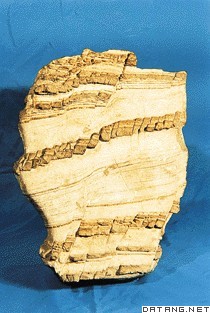1) fault terrace
断层 阶地
2) fault bench
断层阶地
3) fault terrace
断层阶地
4) terrace
阶地
1.
Formation of Keriya River terraces and uplift of Western Kunlun;
克里雅河阶地的形成与西昆仑山隆升
2.
Analysis on the Difference of the Soil Fertility in Different Types of Grey Fluvo-aquic Soil in the First Terrace of Hanjiang River;
汉江一级阶地不同类型灰潮土肥力差异性分析
3.
Authors think that the shuanglong gold placer is a terrace-type gold placer, which is an outwash accumulation due to the glacial and chemical actions in the mid-late pleistocene and the early Holocene epochs.
本文通过对双龙砂金砂床的地貌、沉积物、金的粒度及形态、矿床产出特征的研究,认为该矿床是在中晚更新世及全新世初期的冰川(水)的作用及化学作用下而形成的冰水堆积-阶地型砂金矿床。
5) river terrace
阶地
1.
Because the river terrace is the result of interrupting neotectonic uplift and its forming stages are bound up with the geologic climate cold warm changes,i.
由于河流阶地是间歇性新构造抬升的产物,其形成阶段又与气候的冷暖变化相关,即冷期阶地陡坎形成,暖期阶地堆积物形成。
2.
To understand the evolutionary history of the water system in the upper reaches of Changjiang River,river terraces in the lower reaches of Jinshajiang River(from Shigu to Qiaojia,sampled at Panzhihua,Yuzha,Longjie,Aoga,Malutang,Aqiao and Huadan) and the Chuanjiang River(from Yibin to Fengdu,sampled at Yibin,Luzhou,Hechuan,Lijiatuo,Guangyangdao,Changshou and Fengdu) were analyzed.
以金沙江石鼓-巧家河段与川江宜宾-重庆丰都河段的阶地堆积物物质成分变化为着眼点研究了长江上游水系变迁。
3.
River terraces were developed and preserved well in the outlet of Heishan Gorge of the Yellow River, Northeast margin of the Tibetan Plateau.
青藏高原东北缘黄河黑山峡出口地段夜明山 -长流水沟一带 ,黄河的河流阶地发育和保存的较好。
6) order,stage
阶<地>
7) bench
阶地
8) terraces
阶地
9) bench (Geomorph.)
阶地
10) Faults
断层
1.
Fractures and faults distribution and its effect on gas enrichment areas in Ordos Basin;
鄂尔多斯盆地榆林-神木地区上古生界裂缝和断层分布及其对天然气富集区的影响
2.
Main controlling factors for the vertical seal of faults;
断层垂向封闭形成的主控因素
3.
Evaluation of vertical seal of main faults in k_1d_1 in the north of Wuerxun depression in accumulation period;
乌尔逊凹陷北部成藏期主要断层在大一段内的垂向封闭性
补充资料:断层
| 断层 fault 沿破裂面两侧岩块发生显著相对位移的断裂构造。规模大小不等 ,大者沿走向延伸数百千米 ,常由许多断层组成,可称为断裂带;小者可见于手标本。 几何要素 断层由断层面和断盘构成。断层面是岩块沿之发生相对位移的破裂面。断盘指断层面两侧的岩块,位于断层面之上的称为上盘,断层面之下的称为下盘,如断层面直立,则按岩块相对于断层走向的方位来描述。断层两侧错开的距离统称位移。按测量位移的参考物的不同,有真位移和视位移之分,真位移是断层两侧相当点错开的距离,即断层面上错断前的一点,错断后分成的两个对应点之间的距离,称为总滑距;视位移是断层两侧相当层错开的距离,即错动前的某一岩层,错断后分成两对应层之间的距离,统称断距。 通常按断层的位移性质分为:①上盘相对下降的正断层。②上盘相对上升的逆断层。断层面倾角小于30°的逆断层又称冲断层。正断层和逆断层的两盘相对运动方向均大致平行于断层面倾斜方向,故又统称为倾向滑动断层。③两盘沿断层走向作相对水平运动的平移断层,又称走向滑动断层(简称走滑断层)。
野外认识断层及其性质的主要标志是:① 地层、岩脉、矿脉等地质体在平面或剖面上突然中断或错开。②地层的重复或缺失,这是断层走向与地层走向大致平行的正断层或逆断层常见的一种现象,在断层倾向与地层倾向相反,或二者倾向相同但断层倾角小于地层倾角的情况下,地层重复表明为正断层,地层缺失则为逆断层。③擦痕,断层面上两盘岩石相互摩擦留下的痕迹,可用来鉴别两盘运动方向进而确定断层性质。④牵引构造。断层运动时断层近旁岩层受到拖曳造成的局部弧形弯曲,其凸出的方向大体指示了所在盘的相对运动方向。⑤由断层两盘岩石碎块构成的断层角砾岩、断层运动碾磨成粉末状断层泥等的出现表明该处存在断层。此外还可根据地貌特征(如错断山脊、断层陡崖、水系突然改向)来识别断层的存在。 断层是常见的断裂构造 ,在寻找固体矿床,分析石油、天然气和地下水的运移和储集,评价大型工程地基稳定性以及监测和分析预报地震等方面,断层的研究具有重要的实际意义。 |
说明:补充资料仅用于学习参考,请勿用于其它任何用途。
参考词条
